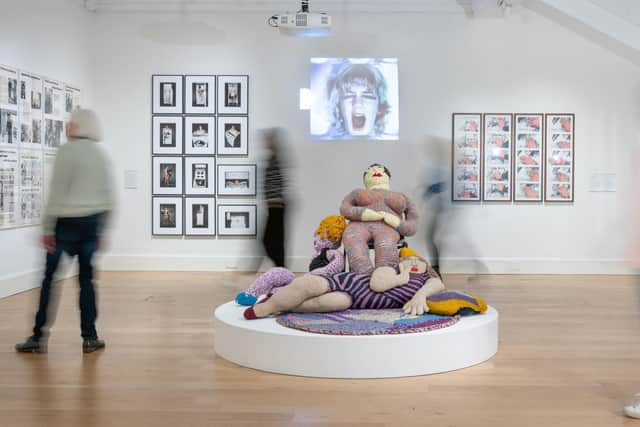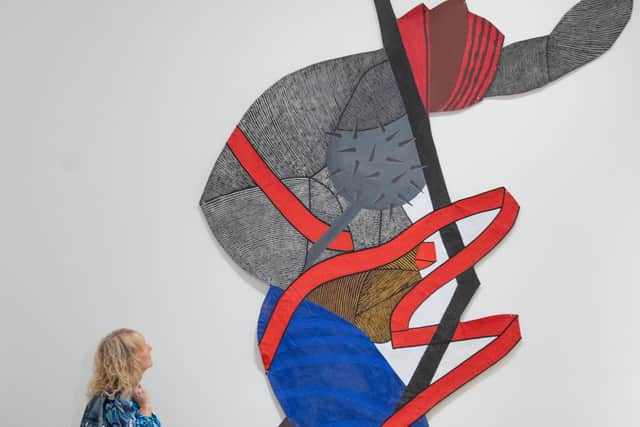Women in Revolt! review - 'Revolutionaries need weapons; art was to hand so they used it'
Women in Revolt! Art and Activism in the UK 1970-1990, Scottish National Gallery of Modern Art, Edinburgh *****
Fifty years ago women were revolting, or at least “women are revolting” is the text on a poster in Women in Revolt! Another poster declares “We’re not beautiful, We’re not ugly, We’re angry!” This was on the back cover of Why Miss World?, a pamphlet produced in 1970 in protest against the Miss World competition held in London early that year. Five women stormed the stage at the Royal Albert Hall. Beauty contests, they argued, treated women as little better than objects or animals in an agricultural show and in 1974 Shirley Cameron, pregnant with twins and dressed as a bunny girl, set herself up in a pen and toured the agricultural shows just as farmers tour their cattle, sheep and pigs.
Advertisement
Hide AdAnother poster from 1970 simply states “Protest” beneath a woman’s face. It is bright green and spews out a flood of female stereotypes including the bride, the beauty queen, and the submissive, the latter borrowed from Allen Jones’s 1969 sculptures presenting women as furniture. Adapting Op-art, the poster is dominated by clashing complementary red and green and was produced by the collective See Red. Women’s collective action, solidarity and mutual support are an important part of the story told here. So too is anger and the translation of anger into art. The show is, however, also a documentary and photographic narrative of women’s actions and protests, individual and collective, over the period 1970 to 1990. The first Woman’s Liberation National Conference was held in February 1970. This was predominately a white occasion, but the exhibition also follows the organisation and progress of black and South Asian women and of lesbians and transpeople, all engaged in a common cause. The catalogue argues intriguingly that after 1990, Saatchi and the YBAS commodified shock in art to such an extent that, tamed, it became toothless. See Red, however, adapted the initials YBA ironically in a poster: “YBA (Why be a) Wife: Is there life after marriage?”


Several early posters use the female cypher, a circle with a cross beneath, but with the clenched fist of revolution added within the circle. In Women against Fascism and Racism, it bursts through a union jack. It was a revolutionary symbol and this was indeed a revolution. We are reminded here, too, of why it was necessary. In 1970 there were no statutory maternity rights or laws against sex discrimination. Married women were still legal dependants of their husbands. Gender inequality was enshrined in the patriarchal status quo in countless other ways, too. Revolutionaries need weapons; art was to hand and they used it. Organisation was needed too, and one of many sub-plots here is an account of the formation of organisations like the Women Artists Collective to win recognition for women artists. They were still blanked by major institutions like the Tate Gallery, custodian at the time both of British art and contemporary art more widely.
The women’s movement was radical and naturally aligned with the left and radical politics. As in the posters, this is reflected in the style of some of the paintings. Monica Sjöö’s Wages for Housework, for instance, aptly deploys the social realist style of Mexican revolutionary painter Diego Rivera. The stress palpably visible in Maureen Scott’s painting Mother and Child at Breaking Point gains impact from a similar, restrained style, but with such creative ferment there was no uniformity. If works like Sam Ainsley’s Warrior Woman V, Rose English’s defiantly female porcelain figures, Rita McGurn’s pile of knitted figures, Elizabeth Radcliffe’s part-woven Cool Bitch and Hot Dog, Maud Sulter’s collages, and Carole Gibbons’s Goddess all share a purpose, they do so in an inventive variety of styles. Perhaps what Janis Jefferies says of her elegant woven work, Double Labia, that she was searching for the specificity of “writing in the feminine” unfettered by “masculine logic” applies to others too.
There is a lot of documentary photography here. Photographs of the several years’ long demonstration at Greenham Common show mounted policemen – cavalry in all but name – deployed against the women. One particularly shocking photo, taken in winter, shows a helmeted policeman on a rearing horse and in the cold it looks as though the horse is breathing smoke. Another photo shows a mounted policeman confronting women protesting against Margaret Thatcher’s anti-social policies. Lesbian art and protests are also documented here, and it was Thatcher’s government that passed Clause 28 banning teaching about homosexuality in schools, but the women’s complaint went much further. A See Red poster, bordered with headlines detailing the impact of Thatcher’s policies on women’s lives, shows her delivering “My message to the women of our nation.” In a speech bubble, it is the single word “Tough!”
Some of the most striking painting is in the section devoted to the art and actions of black and South Asian women. Sutapa Biswas, for instance, adapts the fearsome figure of Kali and the decapitation iconography of Judith and Holofernes in Housewives with Steak Knives. Jennifer Comrie’s By Your Fruits Shall Ye Know Them is a beautiful adaptation of an African mask in charcoal and pastel, but one eye is stitched up painfully with needle and thread. Dog Years by Lubaina Himid, says the artist, shows “a self-assured white man clutching a symbol of power and superiority.” His very large, erect penis has the head of a fierce dog.


If some taboos for women had been broken in the 1960s, in the next decade they were defiantly transgressive. Penny Slinger presents her naked body as a wedding cake. Linder’s Untitled is a collage of a naked woman. Her head is a steam iron and her nipples are smiling mouths with red lips and shining white teeth. Commissioned by the punk band Buzzcocks, this was the sleeve for a single titled Orgasm Addict. Indeed, among a great deal else the show traces the convergence of punk and some aspects of the women’s movement. Both were rebellious and transgressive. Margaret Harrison’s The Little Woman at Home, for instance, shows a woman in punk bondage dress, but with barbed wire around her naked private parts and her foot on a Brillo pad. Police closed her show on grounds of indecency. When she asked why, she was told “It was the men” – evidently similarly dressed. “The images of women were OK.” Helen Chadwick, meanwhile, dressed herself up as white goods. Anne Bean’s Heat shows her face on fire. She was photographed through burning petrol on a sheet of glass. Hannah O’Shea performed with her naked body painted with stripes like a tiger.
Advertisement
Hide AdArt on the walls can make powerful statements as much here undoubtedly does, but it won’t take the fight to the enemy. Jill Posener wittily defaced offensive billboards with graffiti. To a Pretty Polly ad, “Legs smooth as the day you were born”, she added “Born Kicking!” Performance art can be taken into the streets, too, and it was. The Neo-Naturists painted grotesque faces on their bodies and then flashed them in the streets. There is a whole history lesson in this wonderfully detailed show, but I leave you with the thought of Gina Birch’s 3 Minute Scream. Her face is filmed, mouth open in a sustained scream. It is audible all around the gallery.
Until 26 January 2025